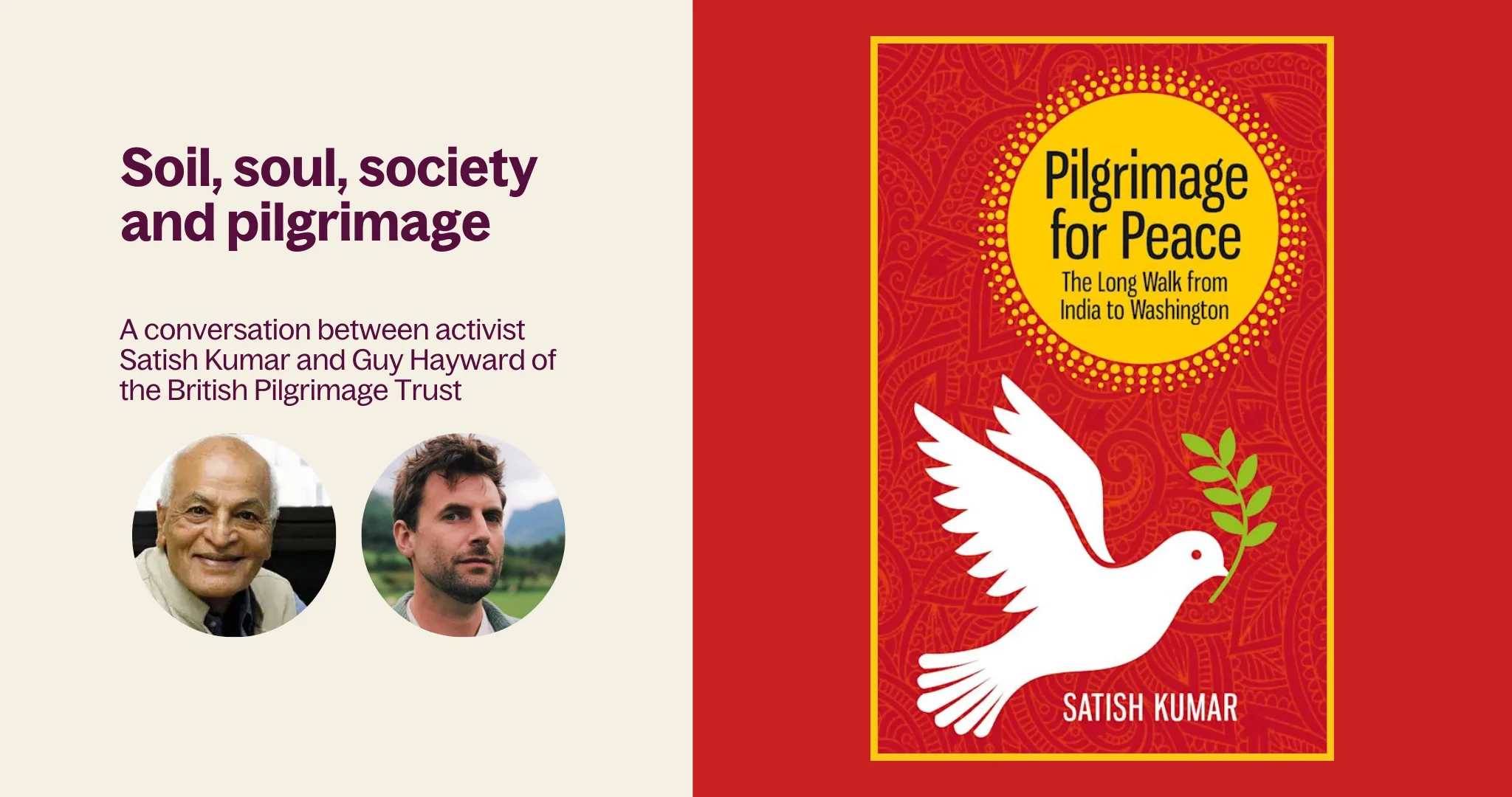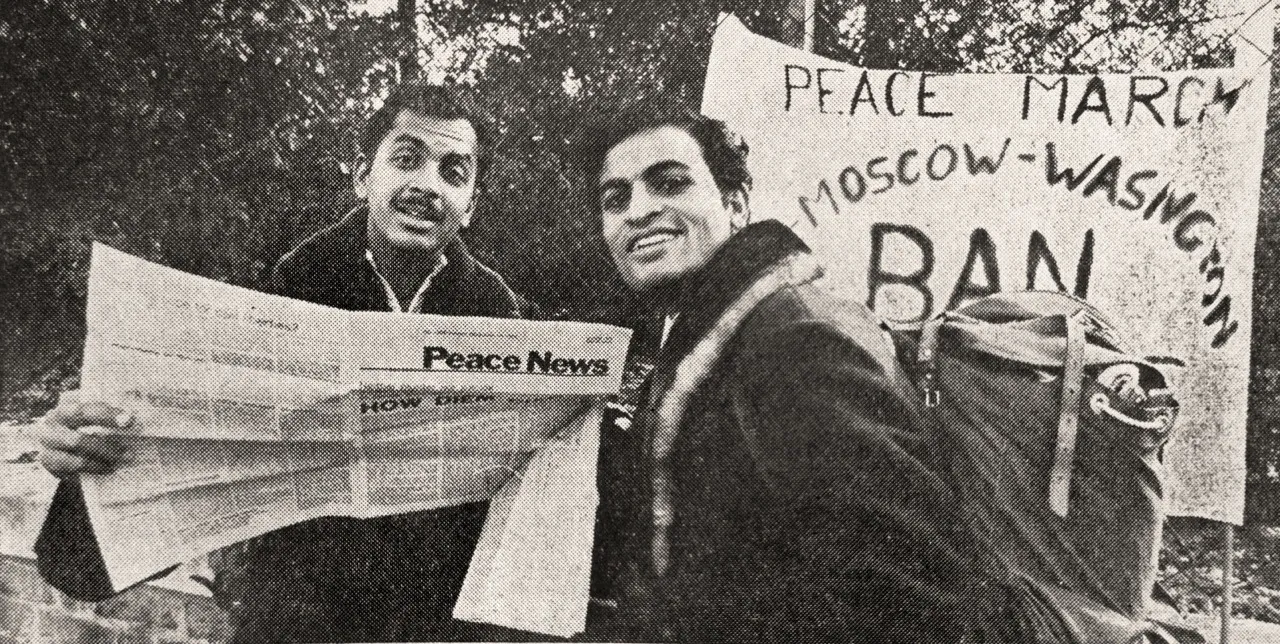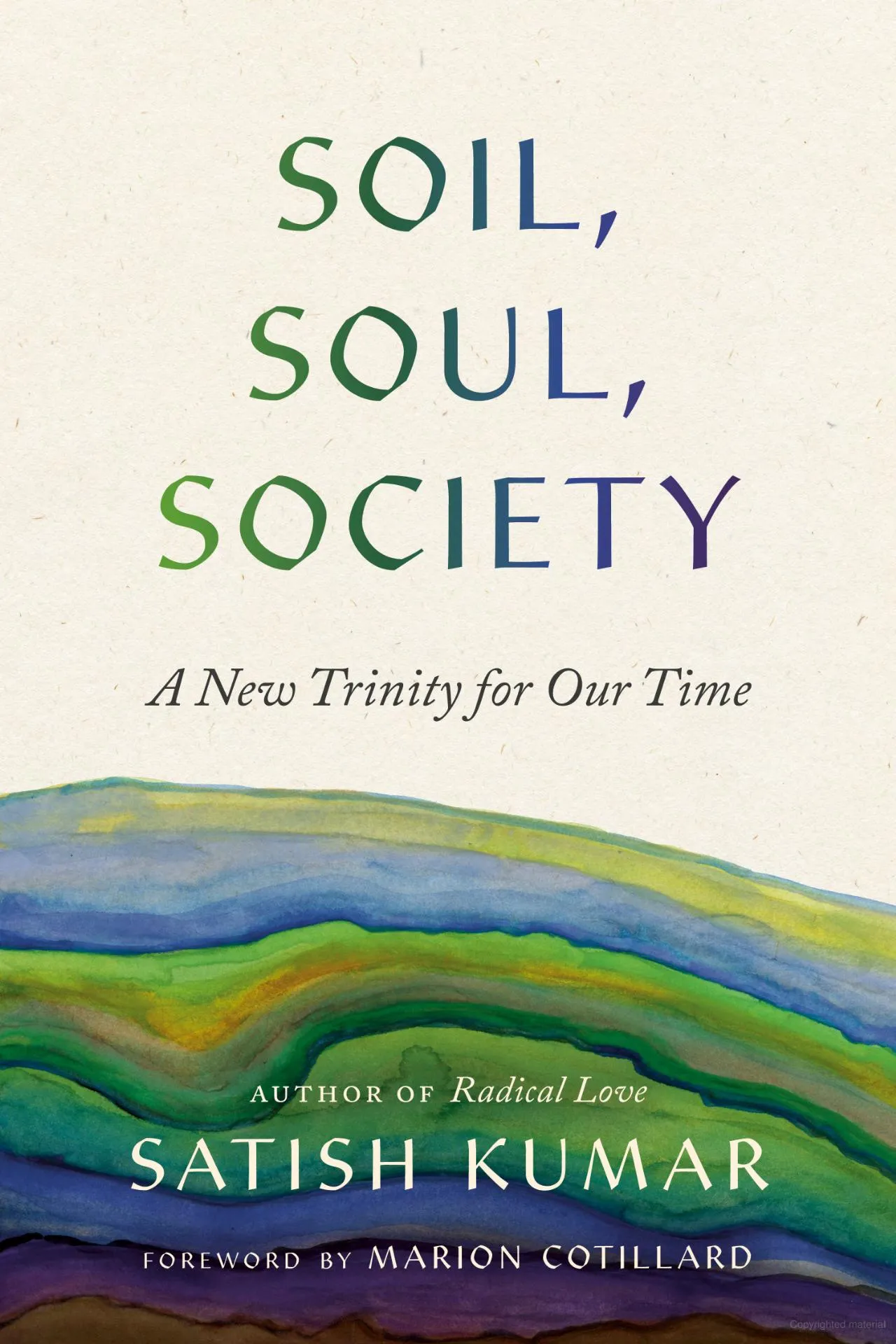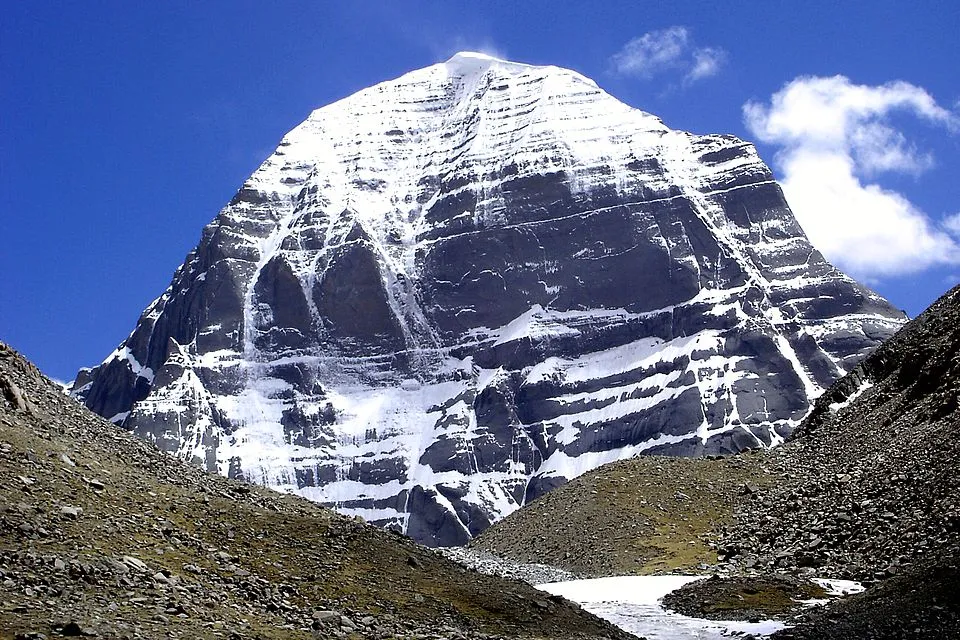Soil, soul, society and pilgrimage: a Conversation with Satish Kumar
12
Aug
,
2025


Walking for Peace and Connection: A Conversation with Satish Kumar
Satish Kumar — peace activist, environmentalist, and former Jain monk — has walked thousands of miles in the name of peace, ecology, and spiritual connection. Known for his 8,000-mile peace walk from India to America, his teachings at Schumacher College, and through Resurgence, his advocacy for “soil, soul, and society,” Satish is a voice of wisdom for our times. Satish is also a Patron of the British Pilgrimage Trust.
In this conversation with British Pilgrimage Trust co-founder Guy Hayward, he reflects on the role of pilgrimage in his life, its philosophical underpinnings, and our power to transform our relationship with the Earth and each other.
Beginnings and the Peace Walk: from monk to pilgrim
Guy Hayward: You’ve been connected with the British Pilgrimage Trust for many years, but your journey began long before, with an extraordinary 8,000-mile peace walk in 1962 from India around the world. And you’ve also walked about Britain. Your work with Schumacher College and all that entails seeks to get us more connected with soil, soul and society. I see you as a sort of ecological holy man.
What led you to becoming a pilgrim and what does pilgrimage mean to you?
Satish Kumar: I have always thought there are two ways to live on planet Earth: one way is to be a tourist and the other is to be a pilgrim.
On my peace walk, I was on a pilgrimage. I could have gone as a tourist, with lots of money in my pocket, and fly, go on trains and stay in hotels and eat in restaurants. But I chose not to. This was a peace pilgrimage, and peace isn’t only the absence of war. Peace is a way of life. You have to make peace with yourself, mentally, and not be disturbed by obstacles. Accept them as part of life.
So I went from New Delhi to Moscow, Paris, London and Washington, at the time the four nuclear capitals of the world. I started at the grave of Mahatma Gandhi, who I believe was a true pilgrim with love in his heart for everyone.
I carried no money, relying entirely on the hospitality and goodwill of strangers. That journey showed me the world’s generosity. When you have love for all living beings, and if you love God, you love everything.
That was my attitude as a pilgrim, rather than being a tourist.

Walking without money
Guy Hayward: Going on pilgrimage definitely entails a mindset. I am reminded of the Fool in the Tarot card deck, walking off the edge of a cliff, looking happy, into the unknown and the place of uncertainty, with no expectations.
It’s interesting what you said about walking with love. We don’t talk about that a lot at our charity. Maybe it’s because we are too British!
What did walking without money teach you?
Satish Kumar: I was walking as a pilgrim for peace. Wars begin with fear. So how do you show you trust yourself, all people, the Universe, God. Ultimate peace comes with trust. If you have money, you buy clothes, food, a bed for the night. You don’t need to trust anyone. You just have to trust money.
So for two and a half years, I didn’t touch money. It taught me that trust is the foundation of any meaningful journey. On my peace walk and later in Britain, I depended on the kindness of strangers. As long as you have fear, you cannot be a pilgrim. A pilgrim has to be fearless. You are in the hands of God. You are in the hands of the Universe. You are in the hands of Destiny. You are here to celebrate life.
When you have no money, you have to trust people and humanity. People offered food, shelter, and warmth simply because I was a traveller — and a pilgrim.
I walked around Britain too, for four months, without money. Two thousand miles around England, Scotland, Wales, I had the same experience of hospitality. Humans are beautiful in every country.
Guy Hayward: Yes, I found this on our first pilgrimage with The British Pilgrimage Trust, which was about three or four weeks along the South Coast of England, without money. So in Britain it’s possible too.
Even in Britain, where we imagine such generosity to be rare, people respond differently when you say, “I am a pilgrim.” They feel moved to help, as if stepping into a Mediaeval story they already know. There’s more kindness in Britain than you might expect. If you’re a traveller you get treated slightly differently, and there’s something magical about saying you’re a pilgrim.
Soil, soul, society and pilgrimage

Guy Hayward: So here we are talking about humanity, but you’ve always been campaigning and speaking for the Earth. Much of your work has been about “soil, soul, and society” as three pillars of a sustainable world, and how you see the world.
Can you tell us about that and how pilgrimage can connect these threads together? How does pilgrimage help people love the Earth more?
Satish Kumar: We put soil as the first in the trinity. We are all soil. The word soil in Latin is humus — which takes us to the word for human. We are not separate from soil. But where soil seems like the external world, the second word soul brings in the internal world. The Earth has soul, animals have soul, we all have soul. Soul means love, kindness, compassion generosity, a sense of service, a sense of gift, respect, nonviolence all those values, including joy.
Unless you have inner and outer and those two things, you’re not complete. You have to have soil and soul together.
So then I wanted the extra emphasis of society, including all human beings that you love. Society is the people we meet along the way.
A true pilgrimage binds all three: soil, soul and society. moving through nature, deepening the inner life, and strengthening community.
A true pilgrimage binds all three: soil, soul and society. moving through nature, deepening the inner life, and strengthening community.
Satish Kumar
We are children of the Earth. Earth is a living being. Gaia. A living being, a living organism. This was James Lovelock’s proposition — that the earth is a self-regulating organism.
We should treat the Earth not merely as a resource for profit. Because of our materialistic ideology, we see matter as a kind of inanimate and not holy or sacred, and we can just use it.
Where our spiritual values are based on the quality of life and experience, our industrial system is based on quantity, where nothing is enough. Despite our wealth, we are not satisfied. When you don’t know when enough is enough, you’ll never have enough. The consequence of that is that we’re discontented and unhappy.
If you have more love for the Earth, the Earth will provide, and you will have enough and be content.
Guy Hayward: How do you think walking the Earth creates that love? Can’t you just stay home and love the Earth?
Satish Kumar: As Arne Naess said in his theory of Deep Ecology, you have to have a deep experience of nature. Deep experience comes when you walk in nature. He walked the Earth. He was a mountaineer.
Every day, I walk in nature and continue to have a deep experience with nature with a deep commitment to nature. Deep experience can only happen when you are in nature. You can’t have that experience when you stay at home.
Guy Hayward: This reminds me of our slogan at the British Pilgrimage Trust “walking is for the body, pilgrimage for the soul.” Because when people hear the word “walking” they focus on the physical element. But there are so many other qualitative aspects to pilgrimage: how many realisations you have and how much joy it has bought into your life.
It was actually a guru in an Indian ashram in Tamil Nadu who I asked after a puja about how I could bring pilgrimage back to Britain. And she said “they need to understand that walking tours are for the body, and pilgrimage is for the soul, and once they know that, they will be interested.”
Sacred Places and the Charging of the Soul
Guy Hayward: Some say certain places hold a special energy. You’ve walked to many sacred places. One of the things the guru Amar mentioned to me is that pilgrim places are like charging points for the soul. You plug in and charge yourself up again. It’s an interesting metaphor. With this disenchantment you mention, there’s something about the materialising of places and paths that connects you. It’s not just about the act of pilgrimage. There are also these special places.
What do you have to say about that, and which pilgrimage places, paths and gatherings stand out to you most?
Satish Kumar: I went to Compostela and Mount Kailash to these ‘charging places.’ Iona is also beautiful, wonderful place and very important to me. These recharged and re-enchanted me and my spirit. The Kumbh Mela in India is the largest pilgrimage gathering in the world — nothing else comes close. We need these charging places, and once you are recharged, you can continue on your journey.
But really, you have to see all places as sacred. Life is sacred. Nature is sacred. Soil is sacred. All are divine. That’s what I have learned from these sacred places. We are so blessed to have such beautiful places.

Water as Sacred Teacher
Guy Hayward: What’s so interesting about the Kumbh Mela for me is that this holy place isn’t a building, but the Kumbh Mela, the largest pilgrimage place in the world, isn’t a building. It’s a meeting of waters – the confluence of rivers: the Ganges, Yamuna, and the invisible Saraswati, which flows underground. It’s a very different basis of reality, being about water.
Satish Kumar: At the Kumbh Mela, Pilgrims come to bathe where these waters meet, believing they are touched by the mystery of life itself. The third river, in that confluence of three rivers, is the soul. You need a third element to be complete.

Sacred Places and Paths in Britain
Guy Hayward: You’ve walked all around Britain. Are there particular places and routes in Britain that are special to you?
Satish Kumar: Iona holds a special place in my heart — its landscape, history, and sense of peace make it deeply sacred. Also, Lindisfarne, which I love, where you have to time your arrival according to the water.. I’ve also walked from Devon to Glastonbury, and that’s a special place for me — lots of legends and stories and history there. And then I also walked to Winchester and followed the Pilgrims' Way to Canterbury.
I also love the South West Way, starting in Poole in Dorset, and then to Cornwall and Devon. And back up to Somerset. You have the ocean on one side, and the hills on the other and it’s very, very beautiful. It goes up and down, just like life!
Guy Hayward: If you were able to go back to one particular place, where would that be.
Satish Kumar: Mount Kailash and Mount Fuji in Japan. Going there represented moments of peace and enlightenment. I felt very at ease with myself there. Those are the two most memorable places in my life.
Pilgrimage as Preparation for Death
Guy Hayward: I feel that as a movement worldwide, we are moving towards more of a reconnection with the land, with our ancestry and with each other.
In the podcast I did with you and Rupert Sheldrake (Death, Dying and Beyond), you said before that pilgrimage can best prepare us for death. Do you really think this practice is the best way to prepare for that great mystery?
Satish Kumar: Yes. A pilgrimage is a rehearsal for the final journey — you leave behind possessions, comforts, and certainties.
In the Indian Hindu tradition, we have four stages of life: the first 25 years are learning, acquiring skills and learning about philosophy, agriculture.
The second stage of life is that of a householder, so you practice what you’ve learned.
The third stage is sharing what you’ve learned with society and community at large, and that’s the beginning of your community. So in India, you say when you reach 50 it’s your time to go on pilgrimage.
And the fourth part is totally pilgrimage.
Advice on how to begin as a pilgrim
Guy Hayward: Many people listening here may have already done a pilgrimage, but others may not have started and don’t know where to begin, or why to begin.
Do you have advice or encouragement for them? Our mission as a charity is to help and encourage people onto the path, so we'd like to hear your answer.
Satish Kumar: My answer is simple. Do you want to be happy? Or do you want to be discontented and unhappy?
If you want to be happy, be a pilgrim. Being a pilgrim is accepting the world. You’ll see the world is a beautiful place.
If you want to be happy, be a pilgrim. Being a pilgrim is accepting the world. You’ll see the world is a beautiful place.
Satish Kumar
Final Thoughts
Guy Hayward: Finally, what gives you hope right now?
Satish Kumar: In the world, we don’t hear or read or hear about the thousands of people at the local, grassroots level doing wonderful work. With generosity of spirit. They are combining the cosmos with the community. The global with the local. People caring for their communities, walking their own landscapes, finding connection close to home. Lots of organic farmers, gardeners, craftsmen, artists, and people are building local communities, serving the poor, and helping others. With a generosity of heart and a magnanimous mind. That’s what is not in the main news, and gives me hope.
Guy Hayward: Like small is beautiful, which is Schumacher’s whole thesis.
Satish Kumar: I think small is truly beautiful. What miracles can be achieved in our small bodies? Our natural world is more horizontal; trees grow to a certain size and then stop, and another tree grows. A few people and economies in the world have become very mega-rich. That’s not equitable.
To learn more about Satish
Resurgence and Resurgence Magazine — Resurgence started, in 1966, to tackle issues that were only just filtering through to the mainstream debate. Articles were published on the endangered environment, renewable energy and ecological economics. E.F. Schumacher wrote regularly about the perils of chemicals in our food, the simplicity of Buddhist economics and the strength of ‘Small is Beautiful’. an educational charity at the forefront of a movement for change. The charity was established in 2006 to further the educational work of Resurgence magazine.
Schumacher College — Schumacher College is boldly experimenting in transdisciplinary education and research; delivering transformative learning experiences, whilst also exploring how holistic education can respond most effectively to what the world needs in this crucial moment in time.
Through Satish Kumar's many books, including Pilgrimage for Peace, Soil, Soul and Society, Radical Love and Elegant Simplicity. A film of his life Radical Love, released in 2024, is an intimate documentary that captures Satish Kumar's transformative journey.
Further reading
.webp)
.svg)
.svg)




_-_geograph.org.uk_-_1626228.webp)

Comments
0 Comments
Login or register to join the conversation.
Tom Jones
Lorem ipsum dolor sit amet, consectetur adipiscing elit. Suspendisse varius enim in eros elementum tristique. Duis cursus, mi quis viverra ornare, eros dolor interdum nulla, ut commodo diam libero vitae erat. Aenean faucibus nibh et justo cursus id rutrum lorem imperdiet. Nunc ut sem vitae risus tristique posuere.
Tom Jones
Lorem ipsum dolor sit amet, consectetur adipiscing elit. Suspendisse varius enim in eros elementum tristique. Duis cursus, mi quis viverra ornare, eros dolor interdum nulla, ut commodo diam libero vitae erat. Aenean faucibus nibh et justo cursus id rutrum lorem imperdiet. Nunc ut sem vitae risus tristique posuere.